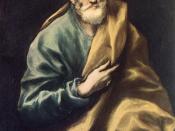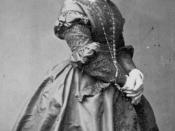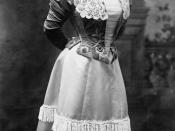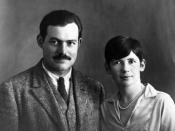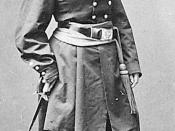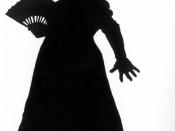Color is used as one of the most important symbols throughout Toni Morrison's novel The Bluest Eye. One particular section in which color is often referred to is the section that describes the earlier life of Pauline, the mother of Pecola. Pauline's life can be split into three stages: one in which there is true color within her, one of solely black and white (ugliness and beauty), and one of only superficial color. As the stages of Pauline's life change, the description of the colors changes with them. In Pauline's section, color can be looked at as a symbol of true beauty, and happiness.
In the beginning of Pauline's section, the reader finds her at home in Kentucky. At this early point of her life, Pauline is very conscious of the colors of the world surrounding her "Whatever portable plurality she found, she organized into neat lines, according to their size, shape.
Or gradations of colorâ¦she would never put the jars of tomatoes next to the green beans" (111). It is in this natural, colorful stage of her life that Pauline meets Cholly, with whom she falls in love, bringing all of the colors from her childhood into her. "All of them colors were in me. Just sitting there. SO when Cholly come up and tickled my foot, it was like them berries, that lemonade, them streaks of green the June bugs make, all come together" (115). At this point of Pauline's life, she is the most happy, and consumed by color.
The next section of Pauline's life begins when she and Cholly move up to Ohio. Black and white takes over this section of Pauline's life. The last point at which a naturally colored figure is described, is on page 116 when Pauline and Cholly had first made the move up to Ohio, and Pauline was still hopeful, acknowledging the "calm blue lake." Also, at this point in the novel, Pauline begins referring to people as black, or white, whereas at earlier points she referred to black people as colored. When Pauline first discovered that the black people of the north were different, she said, "Northern colored folk was different too" (117). However, later on in the section, when Pauline experienced encounters with the colored people, she began thinking in context of black and white "But later on it didn't seem none too bright for a black woman to leave a black man for a white woman" (120). In this section that Pauline has nothing. The only color here is on page 121 when the narrator describes the peeling green paint on the chairs, showing that the small amount of color at this point is peeling away. Pauline finds an escape from this world only while at the movies, a retreat that was still drenched in black and white "There the black-and-white images came together, making a magnificent whole-all projected through the ray of light from above and behind" (122).
In the next third of Pauline's story, she finds color once again, however, this color subsides in physical beauty, and superficial, soulless objects. "The child's pink nightieâ¦the sheets with top hems picked out with blue cornflowersâ¦When she bathed the little Fisher girl, it was in a porcelain tub with slivery taps running infinite quantities of hot, clear waterâ¦Then she brushed the yellow hair" (127). All of the colors in this section describe a superficial beauty that does not sink into Pauline, as did those of her childhood. This is the color that she has come to know at the end. "Only thing I miss sometimes is that rainbow. But like I say, I don't recollect it much anymore" (131). At this last point in Pauline's life, she has found color, but it isn't the real color that she has been able to feel inside of her, and she has also found happiness, but that like the color, is only superficial.
During each stage of Pauline's story, the amount of color in her life coincides with the amount of real happiness in her life. This progression made the story more sensory, allowing the reader to be able to picture the happiness, and colors fading from her life. Color in this novel is indeed one of the most important symbols used, and it helps to truly depict Pauline's life.
